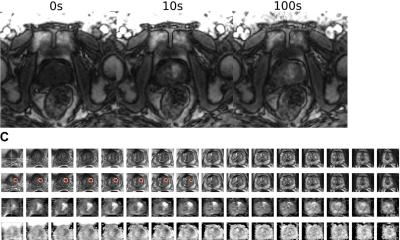Image courtesy of the Netherlands Cancer Institute (NKI)
Article • Prostate cancer treatment
MR-guided radiotherapy: a potential game changer
Prostate radiotherapy techniques have been transformed over the past two decades. One promisting technique in this context is magnetic resonance-guided radiotherapy. The latest clinical results show a dramatic reduction in side effects, improving patient outcomes and quality of life.
Report: Bernard Banga
Prostate cancer is the fourth most common cancer worldwide. According to the International Agency for Research on Cancer (IARC), there were over 1.4 million new cases worldwide in 2020, and by 2040 this is set to rise to 29.5 million new cases and 16.3 million deaths annually.1 Radiotherapy remains a fundamental component of effective treatment, with 50% of all cancer patients receiving it as part of their care. In external beam radiotherapy, radiation is delivered to the prostate five days a week from a machine outside the body.
Prostate radiation therapy: 90% success but short-term side effects

Image source: Dana-Farber Cancer Institute
‘This standard treatment option for prostate cancer can lead to short- and long-term side effects, however, including urinary problems, bowel problems, fatigue, erectile dysfunction and damage to surrounding tissue,’ said US radiation oncologist Dr Jonathan E. Leeman. Oncologists and radiotherapist teams use several main strategies to minimize the risk of these side effects, including careful treatment planning and close patient monitoring during and after radiation therapy.
In a risk-adapted strategy, contemporary radiotherapy treatment algorithms use pretreatment prognostic factors to stratify patients into low-, intermediate-, and high-risk groups. Then, precision radiation delivery techniques, such as intensity-modulated radiation therapy and image-guided radiation therapy, are used to help avoid exposure to normal tissues.
A US-European research collaboration
Magnetic resonance-guided radiotherapy (MRgRT) uses offline MR imaging to help plan radiation volumes in order to ensure accurate tumour targeting while sparing critical normal tissues. MRg-A-SBRT is the product of advances in MR-guided radiotherapy and stereotactic body radiation therapy (SBRT) and emerged at the beginning of the decade from a collaboration between US and European researchers and clinicians. These include the Department of Radiation Oncology at Stanford University, Memorial Sloan Kettering Cancer Center (MSKCC), New-York the Belgian University Medical Center Utrecht (UMC Utrecht) and the German Research Center for Oncology (DKFZ) in Heidelberg.
SBRT uses MRI ‘to deliver high doses of radiation to precise targets in the body’, said Leeman. Real-time monitoring enables treatment to be adapted on a daily basis, tailoring radiation delivery to prostate changes and thus reducing side effects.
Prospective study analyses data from 29 clinical trials
This technology has already been used successfully to treat breast, prostate, pancreatic, liver, lung and limited metastatic cancers, in addition to non-cancer indications such as cardiac ablation.2 MRg-A-SBRT enables clinicians to accurately target the prostate while sparing bladder, urethra, and rectal tissue. However, its impact on clinical outcomes and side effects compared to standard computed tomography-guided SBRT (CT-SBRT) was unclear.
A team of researchers from the Dana-Farber Cancer Institute has just published a large study of MR-guided daily adaptive SBRT in Cancer, which directly assesses its benefits compared to standard techniques for the first time.3
60% reduction in short-term bowel side effects
The study combined data from 29 clinical trials including a total of 2,547 patients to compare the side effects of MRg-A-SBRT to more conventional treatment methods with CT guidance but without daily adjustments. ‘We found that the risk of short-term urinary side effects was reduced by 44% [a 1.79-fold reduction] and the risk of short-term bowel side effects was reduced by 60% [a 2.5-fold reduction]’, said Leeman.
While these results strongly support the use of MRg-A-SBRT as an effective treatment option in prostate cancer, Leeman noted that longer follow-up is required to see whether the short-term benefits will lead to more impactful long-term benefits for benefits.
Portrait:
Dr Jonathan E. Leeman is a radiation oncologist at Dana-Farber Cancer Institute and Brigham and Women's Hospital, Harvard Medical School, USA. He specializes in the treatment of prostate cancer and MRI-guided radiation treatment for multiple cancer types. Dr Leeman's clinical expertise lies in the areas of MRI-guided radiotherapy, adaptive radiotherapy, and prostate cancer. He serves as the physician lead of the MRI-guided radiation program at Dana-Farber Cancer Institute. His research focuses on the treatment of prostate cancer and the development of MRI-guided radiation therapy. He is also an instructor and has specialties in cancer research, radiation oncology, prostate cancer, and head and neck cancer.
References:
- Abdel-Wahab et al.: Global Radiotherapy: Current Status and Future Directions—White Paper; JCO Global Oncology 2021
- Ladbury et al.: Clinical Applications of Magnetic Resonance-Guided Radiotherapy: A Narrative Review; Cancers 2023
- Leeman et al.: Acute toxicity comparison of magnetic resonance-guided adaptive versus fiducial or computed tomography-guided non-adaptive prostate stereotactic body radiotherapy: A systematic review and meta-analysis; Cancer 2023
08.04.2024











